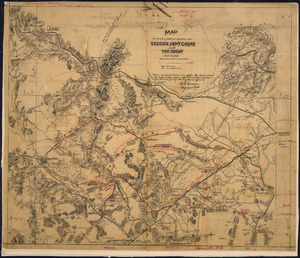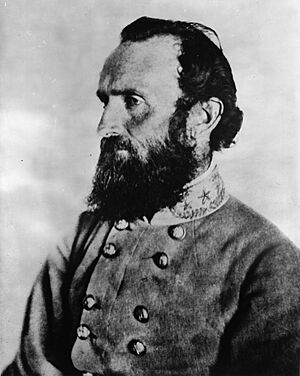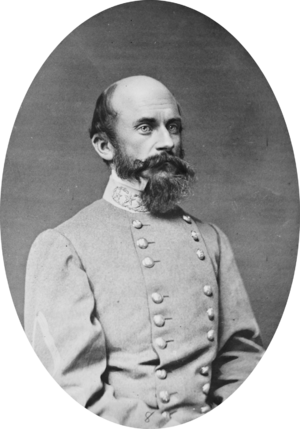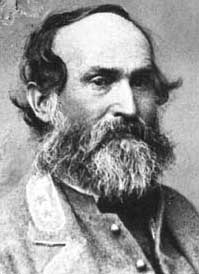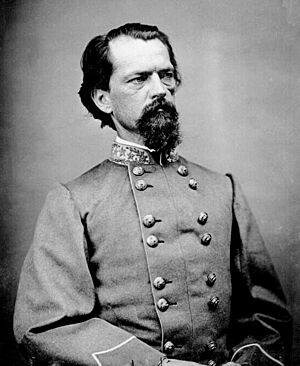Second Corps, Army of Northern Virginia facts for kids
Quick facts for kids Second Corps,Army of Northern Virginia |
|
|---|---|
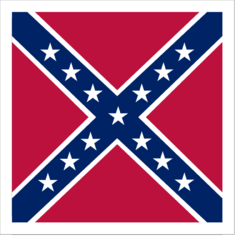
Battle flag of the Army of Northern Virginia
|
|
| Active | 1862–1865 |
| Country | |
| Branch | |
| Type | Corps |
| Part of | Army of Northern Virginia |
The Second Corps of the Army of Northern Virginia was an important military group in the Confederate Army of Northern Virginia during the American Civil War. It was officially formed after the Battle of Sharpsburg in 1862. However, its units had been working together as a "corps" for some time before that. The Second Corps became known for its tough fighting, especially under its famous first commander, Thomas J. "Stonewall" Jackson.
Contents
How the Second Corps Was Formed
The soldiers who made up the Second Corps were first part of the Second Corps of the Confederate Army of the Potomac. This group was led by Major General Gustavus W. Smith. Later, General Robert E. Lee took over and reorganized his army. He created this corps and put Lieutenant General Jackson in charge. Lee also created another corps led by Lt. Gen. James Longstreet. This change happened after Lee saw how his commanders performed during the Seven Days Campaign.
Stonewall Jackson's Command (1862-1863)
General Jackson led what became the Second Corps from July 13, 1862, until he died in May 1863. This happened after the Battle of Chancellorsville. Jackson was officially promoted to lieutenant general on October 10, 1862. His group then became known as the Second Corps around November 6.
Jackson's corps fought bravely at the Battle of Fredericksburg. Their most famous moment was during the Battle of Chancellorsville. There, Jackson led a surprise attack on the side of the Union army. This attack caused a lot of confusion for the Union forces. Sadly, Jackson was badly wounded after this battle and died soon after. Losing Jackson was a huge blow to General Lee and his army. Many historians believe it changed how Lee had to lead his army from then on.
Richard S. Ewell Takes Command (1863-1864)
After Jackson's death, General Lee gave command of the Second Corps to Lt. Gen. Richard S. Ewell. Ewell had worked under Jackson before and knew the corps well. However, the Second Corps became smaller when Ewell took over. This was because General Lee decided to create a new Third Corps under A. P. Hill.
Ewell led the Second Corps during the Gettysburg Campaign. His troops won a big victory at the Second Battle of Winchester. Ewell continued to lead the corps in early 1864 at the Battle of the Wilderness and the Battle of Spotsylvania. However, Lee felt that Ewell's leadership was not as strong as before. So, Lee moved Ewell to a different role on May 29, 1864.
Jubal A. Early's Leadership (1864)
After Ewell, Lt. Gen. Jubal A. Early took command. Early had a lot of experience. He had already led parts of the Second and Third Corps temporarily. He had also served under both Jackson and Ewell.
In June 1864, Lee sent Early and the Second Corps on a mission. They were to invade the Union again. The goal was to make Union General Ulysses S. Grant stop attacking Lee's main army. Early led the Second Corps, which was called the Army of the Valley, north through the Shenandoah Valley. They reached the edge of Washington, D.C. at Fort Stevens. Along the way, they raided farms and railroads in Maryland and Pennsylvania.
But this invasion did not last long. The Union army, led by Maj. Gen. Philip Sheridan, pushed Early back into Virginia. Sheridan then began his famous "Burning" of the Valley. His troops destroyed crops, livestock, and farms. This was to prevent the Confederates from using them. Early's army, mostly made up of the Second Corps, suffered heavy losses in battles like Winchester and Cedar Creek. By December, most of Early's forces were sent back to Richmond.
John B. Gordon's Final Command (1864-1865)
The Second Corps then rejoined the main Army of Northern Virginia. Maj. Gen. John B. Gordon took command on December 20, 1864. Gordon led the corps, which was the "left wing" of Lee's army, until it surrendered. This happened at Appomattox Court House, Virginia, on April 9, 1865.
One important action under Gordon was the Battle of Fort Stedman. The corps launched a surprise attack and had some success. But Union reserves pushed them back. Gordon's command was also at the front of the army during its last fight near Appomattox Court House. Finally, Gordon and the Second Corps led the parade of Confederate infantry during the surrender.
Images for kids


